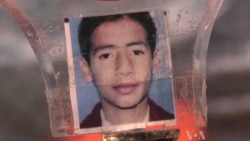SRINAGAR, INDIAN-KASHMIR —
Three years ago, Wamiq Farooq went out to play cricket and never came home.
Al that is left for his parents and older brother, Danish, are school photos, certificates and trophies symbolizing the unfulfilled dreams of a future the 12-year old Kashmiri never had.
“He was really brilliant, seriously. I can’t explain how brilliant he was, how good of a student he was, seriously. I was really proud of him,” Danish Farooq says as his eyes well up with tears.
A Life Cut Short
Farooq says his younger brother was playing with his friends near a stadium in Indian-Kashmir’s main town of Srinagar on January 30, 2010, when police officers drove by and threw a teargas shell. It struck the back of Wamiq’s head and killed him. Witnesses say the attack was unprovoked, and that the boy was not taking part in stone throwing or any other unrest.
In August, a local judge issued arrest warrants for the two officers for culpable homicide, saying police acted recklessly. In the ruling, the judge said tear gas shells are “not a weapon of offense but only intended to disarm miscreants.” Chief Judicial Magistrate Rajeev Gupta also warned police personnel to use only as much force as necessary to disperse an unruly mob.
Mirwaiz Umar Farooq, chair of the separatist umbrella organization Hurriyat Conference, says the ruling in Wamiq Farooq’s death sets an important precedent that such cases must be investigated and brought to justice.
“A commission of inquiry has to be sought into for all those killings, all those fake encounters, all the police brutality that has happened over these years,” he told VOA just minutes after learning of the court ruling. “And I must add to it that even the Hurriyat Conference is not averse to looking into issues where armed people or militants may have committed violations of human rights.
Human Rights
International human rights organizations have long accused Indian security forces of using excessive force, including firing live ammunition, during pro-independence protests in the disputed Himalayan region.
Human Rights
International human rights organizations have long accused Indian security forces of using excessive force, including firing live ammunition, during pro-independence protests in the disputed Himalayan region.
Kashmir is divided between India and Pakistan and claimed in full by both.
More than 60,000 people have been killed in an armed insurgency that began in the late 1980’s, with separatists fighting for self-determination.
Wamiq Farooq’s death in early 2010 was the beginning of a year of deadly clashes between security forces and stone-throwing protesters. At least 100 people were killed, mostly demonstrators who were shot by police.
Kashmir Inspector General of Police Abdul Ghani Mir says the unrest of 2010 was a turning point for his force.
“The J&K (Jammu and Kashmir) has learned its lessons. In the last three years, 2011, 2012 and 2013, there have been protests, there has been stone pelting, the incidents’ triggers have been there, these things have been there, but we have not seen that any killings have taken place during the protests because we have evolved our responses,” Mir said.
Radha Kumar was one of three government-appointed mediators sent to Kashmir following the violence of 2010. The political scientist acknowledges security reforms and fewer human rights violations in recent years, but says the government has not done enough to address people’s grievances, including addressing alleged human rights abuses committed by security forces.
“Kashmiris showed a huge will in trying to put the events of 2010 behind them and move forward on tourism, economy and other issues. But when you say ‘behind them,’ it doesn’t mean that you are giving up on justice, ” Kumar said.
As for Firdousa Farooq, she never gave up on justice for her son Wamiq.
“This is not just a win for me, but for the entire Kashmir. This is a win for all those who have experienced injustice and for those yet to come. Who knows how long this will go on,” she said.
Her legal battle over, this mother returns to her now quiet Srinagar home, still longing to hear the footsteps of a little boy whose life was cut short.








